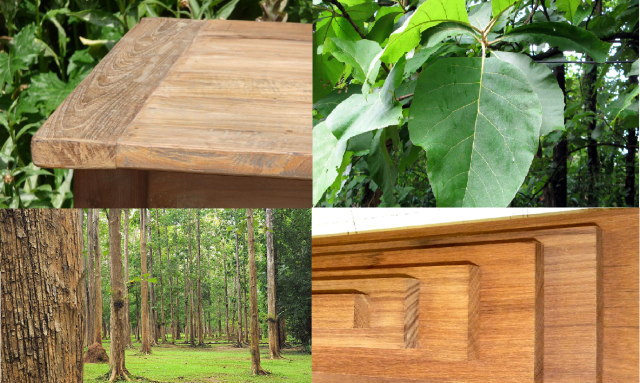Acacia (a.k.a Babul in India) is a bushy kind of a tree that takes a lot of time to mature. It is known for its huge thorns. It is indigenous to the Indian Sub-continent as also in Tropical Africa, Burma, Sri Lanka, Saudi Arabia, Egypt and in West and East Sudan. In India, natural babul forests are generally found in Maharashtra, Gujarat, Andhra Pradesh, Rajasthan, Haryana, and Karnataka. The plant grows naturally and is also widely planted in almost all states in India except North-east and Kashmir.
It is a strong hardwood that is moderately heavy and looks quite good with its eye-catching color and straight/wavy grain pattern. The heartwood is reddish brown in colour, while the sapwood is yellowish-white. The wood is easy to work with for carpenters and the texture of the wood allows for a smooth fine finish. Though it is not as durable as teak wood, furniture made from solid acacia wood can still last for many long years, and hence serves as a cheaper alternative to teak wood. It is used to make cabinets, tables and chairs, sofa sets etc. and is also used for making wooden flooring.

To the untrained eye, acacia and teak could be similar. And it is a common practice to sell cheap acacia wood as teak. The wood is strong and should have about 12% moisture content when air-dried, ready for wood-working. The oil content in Acacia is much lower than in Teak and therefore would require some finishing work (as compared to Teak which has a natural finish because of the rich inherent oils).
Though heavier than teak, acacia wood is equally good provided it is seasoned, said a scientist at the Institute of Wood Science and technology (IWST). He said acacia is sold at Rs 400 per cubic feet, whereas teak costs between Rs 1,600 to Rs 2,000. However, since acacia wood is equally good for furniture, IWST is trying to popularise growing Acacia outside forests, by initiating measures in the field of agroforestry. The best teak wood in India comes from Hunsur in Karnataka and Baitul in Madhya Pradesh. (link)

Teak (Tectona Grandis) is considered as the king of Timber. It’s rich oils and tight grain makes it naturally termite resistant. Due to the rich natural oils that the wood has, it doesn’t need any top coating and can be used as a naturally finished product. The heartwood is slight yellow and becomes darker as it matures, giving a beautiful blend of dark yellow and brown.

Acacia Properties
- More varieties than teak, with more variations in grain pattern.
- Interlocked or curved grains that will shear with time
- Reddish-brown tint that doesn’t darken with time
- Accepts stain better than teak.
- Requires a top-coat finish.
Teak Properties
- Straight-grain patterns
- A light-brown color that fades to chocolate brown color with age.
- Doesn’t require a top coat as the natural oils in the wood protect the wood and close it naturally.
- Tight grain pattern which is less likely to shear
- Less likely to warp or crack than acacia.
- Considered as the gold standard of wood for exterior durability with or without sealant.
Acacia Advantages
- Swirling, wavy patterns and outstanding color variations create a more complex appearance than teak.
- Can be polished to a higher sheen than teak, primarily because of a recommended top coat of polyurethane.
Teak Advantages
- Can be used without a top coating.
- Has more natural moisture resistance than any other hardwood.
- Rich, natural dark color adds warmth and consistency to the furniture.
- One of the most expensive woods.
- Was originally used for boat-building extensively for its properties
Manufacturers will buy different planks from size (length) of 1.5 feet to 8 feet planks and with thickness of 16mm to 25mm being the ready material, and you can get other thicknesses too basis your requirement. And, the below is how they store these planks and they finger-joint the smaller planks and make a longer section or you can buy a longer section too. Below pictures are of Sheesham wood planks of different thickness and length which are finger-jointed in the factory (after buying the smaller length planks). In India, the cost per cubic feet (not per plank) in 1.5 feet to 8 feet length will be around 550 -750 INR/cft for Acacia and will be around 800-1200/cft for Sheesham.
The typical solid-wood working process is as follows:
- Impregnation
- Seasoning
- Timber Sort
- Double side planer
- RIP Saws
- Cross Cut Lines
- Finger Jointers
- Edge Jointers
- Abrasive Sanding
- Grid Trimming
- Contour Sawing
- Contour Profiling
- Turning
- Machining/Routing/Drilling
- Sub-assembly
- Sanding
- Polishing & Finishing
- Assembly
- Inspection & Packaging
Thank you.
Source(s):
- https://www.deccanherald.com/content/187438/dealers-sell-cheaper-acacia-wood.html
- http://www.hobbithouseinc.com/personal/woodpics/_anatomy/interlocked%20grain/_interlocked%20grain.htm
- http://teakpatiofurnitureworld.com/best-teak-alternative-wood-outdoor-furniture
- https://www.deccanherald.com/content/187438/dealers-sell-cheaper-acacia-wood.html
- https://www.hunker.com/13401525/acacia-vs-teak
- http://www.vwoods.in/products.php?product=door-frames
- http://www.unicminds.com





You must be logged in to post a comment.